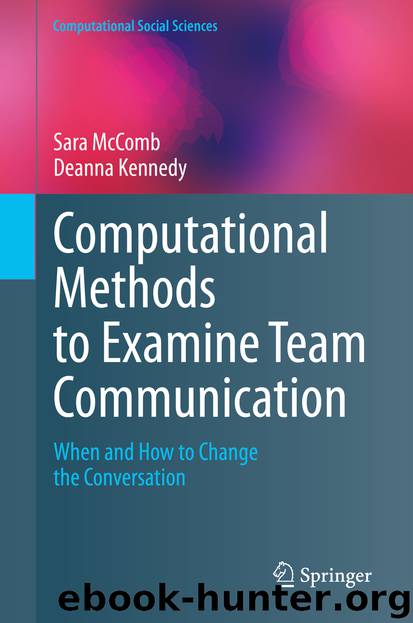Computational Methods to Examine Team Communication by Sara McComb & Deanna Kennedy

Author:Sara McComb & Deanna Kennedy
Language: eng
Format: epub
ISBN: 9783030361594
Publisher: Springer International Publishing
Theoretical Implications and Future Research
Our results provide confirmation of the theoretical frameworks underlying this research study. First, Marks and colleagues (2001: 360) posit that “teams are actively engaged in different types of taskwork at different phases of task accomplishment.” Indeed, they forward their recurring phase model of team processes because the cross-sectional and/or unidimensional perspectives do not adequately portray the complexity of team processes. Overwhelmingly, our results suggest that teams across all conditions shift from transition processes toward more action during both performance episodes, require less emphasis on transition processes during the second performance episode, and decrease the complexity of their conversations over time. Thus, these findings confirm that team processes change over time to meet the varying demands of their task.
Second, Bartunek and Woodman (2015) identify timing and pacing as two critical temporal dimensions of change. Time represents “the need to act” and pacing encompasses the speed that teams need “especially at the beginning … to generate enough momentum …” to complete their assigned task (Bartunek and Woodman 2015, 170). Our results provide insight into timing by identifying when certain processes may be used by teams. For example, the frequency with which the majority of teams discussed mission analysis peaked during the first quartile and then the frequency reduced or remained the same across subsequent quartiles, whereas tactical strategy was prominent throughout the first two quartiles before the frequency significantly reduced in the third and fourth quartiles. The results also depict pacing in team communication. Specifically, teams engage in substantially more complex conversations as they orient themselves to what they have been tasked to accomplish and determining how they are going to accomplish it, particularly during the second quartile. For example, all types of teams experience significant reductions in the numbers of transitions among topics from the first to the second quartile. These results, therefore, provide evidentiary support for applying at least the timing and pacing temporal dimensions within the team domain.
Our research also extends Gersick’s (1988, 1989) punctuated equilibrium model of group development. In her research, Gersick identified a phase transition at the midpoint of team activity where team members significantly changed the manner in which they were collaborating no matter how long the teams’ lifecycles were. In our results, we identified significant changes across four quartiles (versus Gersick’s halves), particularly in the teams’ action, mission analysis, and tactical strategy processes. These shifts across quartiles suggest that researchers may benefit from including more time periods in their longitudinal examinations of team behavior.
In this study, we focus on the various transition processes teams employ to organize themselves for action. In addition to these transition processes, Marks and colleagues (2001) delineate four action processes (i.e., monitoring progress toward goals, systems monitoring, team monitoring and backup behavior, and coordination activities). Team science may benefit from an in depth examination of the specific action processes to identify when and at pace they are needed to facilitate team activity.
Download
This site does not store any files on its server. We only index and link to content provided by other sites. Please contact the content providers to delete copyright contents if any and email us, we'll remove relevant links or contents immediately.
Bad Blood by John Carreyrou(6583)
Rich Dad Poor Dad by Robert T. Kiyosaki(6513)
Principles: Life and Work by Ray Dalio(6296)
Playing to Win_ How Strategy Really Works by A.G. Lafley & Roger L. Martin(6083)
Management Strategies for the Cloud Revolution: How Cloud Computing Is Transforming Business and Why You Can't Afford to Be Left Behind by Charles Babcock(4546)
The Confidence Code by Katty Kay(4220)
Thinking in Bets by Annie Duke(4185)
American Kingpin by Nick Bilton(3819)
Delivering Happiness by Tony Hsieh(3396)
Project Animal Farm: An Accidental Journey into the Secret World of Farming and the Truth About Our Food by Sonia Faruqi(3189)
The Power of Habit by Charles Duhigg(3094)
The Tyranny of Metrics by Jerry Z. Muller(3028)
Brotopia by Emily Chang(3026)
Mastering Bitcoin: Programming the Open Blockchain by Andreas M. Antonopoulos(3011)
The Marketing Plan Handbook: Develop Big-Picture Marketing Plans for Pennies on the Dollar by Robert W. Bly(3006)
I Live in the Future & Here's How It Works by Nick Bilton(2960)
The Content Trap by Bharat Anand(2887)
Applied Empathy by Michael Ventura(2864)
Building a StoryBrand by Donald Miller(2863)
